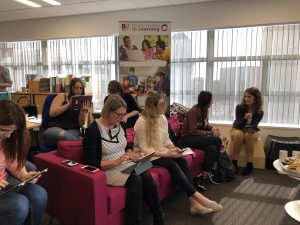To celebrate International Women’s Day 2019, the Centre for Excellence in Learning and the BU Women’s Academic Network co-produced a ‘Women in technology’ and ‘Uncelebrated Women’ event, offered to staff and students across BU.
The first workshop, Coding and Learning was led by the inspirational Dr Carina Buckley, Instructional Design Manager at Solent Learning and Teaching Institute, and her colleague Sarah Cotton who joined staff from across BU as part of the CEL/ BU Womens’s Academic Network (WAN) event, and led on our coding and learning taster activity; and CEL technologists Kathy Abbasirad, Jenna Giles-Bodily, Kar Stanton and Tracey Webb developed materials and offered a session on enhancing Brightspace, our institutional VLE using simple coding. Materials will be available shortly via our usual guidance for Brightspace, but posters produced for the event are available for those keen to take an early look from Kar.
Here is the coding morning report from Carina, Sarah and Hannah (who worked on the materials):
Developing your coding skills on International Women’s Day
Technology as a field contains two important divisions: male and female, and robots and dinosaurs. Neither of these divisions are inevitable, nor are they irreparable.
First of all, the gender gap. In a 2016 US survey of occupations, men accounted for around 76% of all computing and software-related occupations. Yet this never used to be the case, and some of the most important people in computing history have been women:
- Rear Admiral Grace Hopper‘s work led in 1959 to the development of COBOL, a programming language still used today. In 1969 the Data Processing Management Association named her ‘Computer Science Man of the Year’.
- The technology that underpins most modern search engines was created in 1972 by Karen Spärck Jones, a British computer programmer. The New York Times got around to publishing her obituary 12 years after she died.
- In 1945–46, Jean Bartik and five other women developed and codified many of the foundations of software programming while working on the world’s first general-purpose computer – Electronic Numerical Integrator And Computer (ENIAC). They were excluded from the celebration dinner when ENIAC was completed.
The second division is more of an age gap. Today, kids code for fun, and are often taught it at school. They will always be ahead, like small and relentless robots, and some of us can feel like dinosaurs trying and failing to keep up.
However, there are easy ways to upskill and keep pace with developing technology. We introduced participants to three easy coding programmes:

The online code editor Codepen guides you through HTML and CSS, the fundamental building blocks of any static website.
Scratch is a fun way to build code-based animations using an easy block-like interface. It’s fun for kids but wholly enjoyable for adults too.
Finally, Python is widely-used in industry and is an accessible text-based programming language, and the Raspberry Pi organisation provides an easy way in.
No matter who you are, or how old, you can always get into coding!








